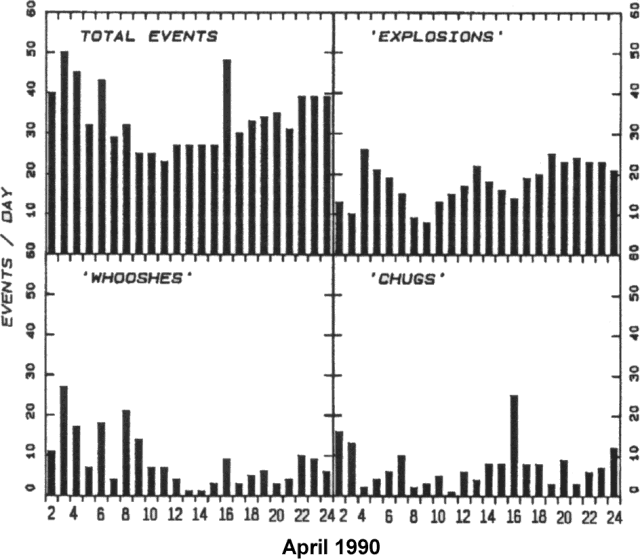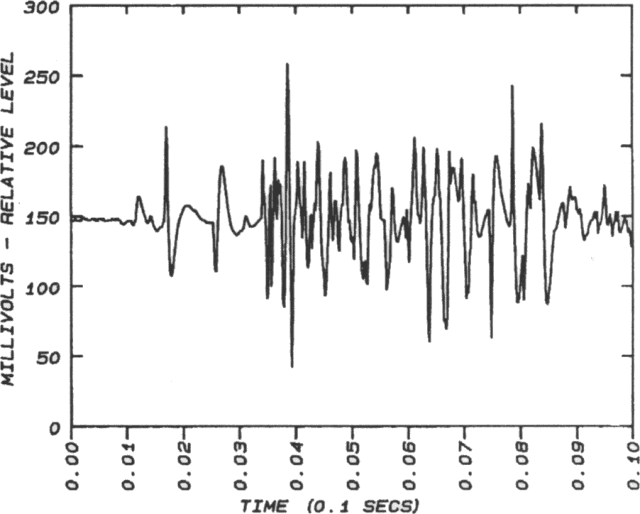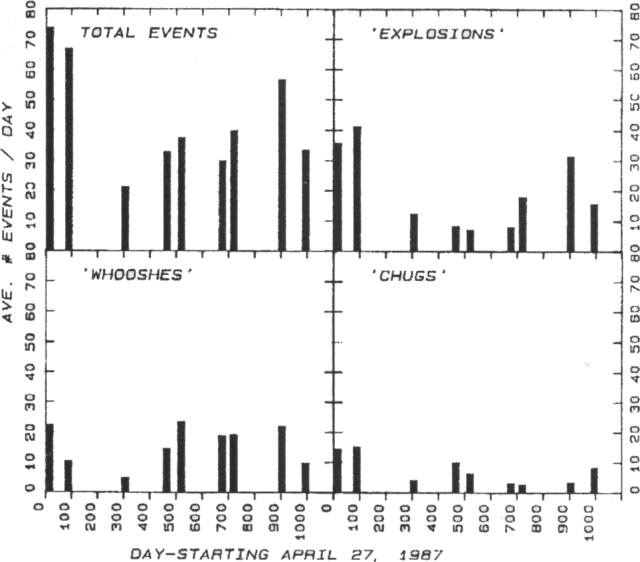Report on Arenal (Costa Rica) — April 1990
Bulletin of the Global Volcanism Network, vol. 15, no. 4 (April 1990)
Managing Editor: Lindsay McClelland.
Arenal (Costa Rica) Vigorous Strombolian activity; lava flows; little change in chemistry over last 3 years
Please cite this report as:
Global Volcanism Program, 1990. Report on Arenal (Costa Rica) (McClelland, L., ed.). Bulletin of the Global Volcanism Network, 15:4. Smithsonian Institution. https://doi.org/10.5479/si.GVP.BGVN199004-345033
Arenal
Costa Rica
10.463°N, 84.703°W; summit elev. 1670 m
All times are local (unless otherwise noted)
A significant increase in Strombolian activity during March started with a corresponding increase in volcanic earthquakes at the beginning of the month. Between 20 and 24 March, substantially enhanced tremor accompanied lava production from Crater C. A small flow descended the NW flank toward the Río Tabacón, reaching ~700 m elevation. Lava continued to flow onto the NW flank in April, and a second flow began to advance down the S flank. Strombolian eruptions were larger and more frequent than in previous months and gas emission was continuous. Blocks and bombs fell 800-900 m from Crater C. Ash columns rose as much as 1 km and were carried by the wind toward the NW, W, and SW, the area most affected by acid rain. The activity occasionally produced small nuées ardentes.
Arenal remained highly active 1-22 April during 24 hour/day observations by Smithsonian Research Expeditions. Activity consisted of frequent pyroclastic events as well as production of small block lava flows that advanced down the S and WNW flanks. Flow movement down the NNW slope, the dominant direction during the past 3 years, had ceased. A pronounced leveed ridge had been produced by the most active (WNW) flow. Smaller flows were extruded from a small fissure ~100 m S of the summit crater rim, and a few hundred meters S from a spillover along the SSE part of the crater rim. Frequent explosions continued to eject blocks and bombs around the crater. Some fell more than a kilometer away, creating extremely hazardous conditions for ground observation of the crater area. Because the active flow fronts were all within the impact zone, there were no direct observations of flow rates.
Over the 23-day period, 807 pyroclastic events were recorded (figure 25), including sharp explosions [Type 1 in 14:06]; intense gas, block and bomb fountains [Type 2 in 14:06]; and rhythmic, less intense gas emissions, commonly accompanied by blocks and bombs [Type 3 in 14:06]. A "flashing arc", as described by Perret (1912) from eruptions at Vesuvius and Mont. Pelée, was observed from an explosion on 4 April at 1047 (figure 26). Two blocky pyroclastic flows moved down the S flank, each reaching ~800 m from the crater.
The level of pyroclastic activity (figure 27), sampled at various times over the past 1,000 days at 10-23-day intervals, as well as lava flow directions and rates, continued to show wide variations on both day-to-day and longer time scales. However, the volume of individual lava and pyroclastic flows appears to have gradually declined over the 1,000-day period, with few reaching more than ~800 m from the summit crater. The crater appeared to contain at least two vents, with the S vent the source of much of the pyroclastic activity, while the lava flows emerged from the vent to its N and W.
Chemical compositions of the highly phyric basaltic andesitic blocks and bombs (table 4) have remained essentially constant over the past 3 years, reflecting both a constant source composition and high magma viscosity. However, petrography has varied, particularly the glass/crystal ratio, high in bombs and near-vent lava flows and much lower in blocks.
Table 4. Compositions of 1987-89 eruption products from Arenal; XRF analyses by Joseph Nelen, SI. The August 1989 lava flow sample is from J. Barquero and E. Fernández. pf = bomb from pyroclastic flow; b = ejected block; B = ejected scoriaceous bomb; L = lava flow.
| Sample | EW51-2(pf) | EW2-105(b) | EW5-1(b) | EW5-2(B) | EW5-3(B) | 82389(L) |
| Date | 1986 | 07 May 87 | 20 Feb 89 | 20 Feb 89 | 20 Feb 89 | 23 Aug 89 |
| SiO2 | 54.84 | 54.90 | 54.82 | 54.52 | 55.09 | 55.82 |
| TiO2 | 0.64 | 0.61 | 0.62 | 0.62 | 0.61 | 0.63 |
| Al2O3 | 18.59 | 18.91 | 19.00 | 18.78 | 19.24 | 19.09 |
| Fe2O3 | 1.55 | 2.06 | 2.01 | 2.10 | 0.32 | 2.42 |
| FeO | 5.88 | 5.32 | 5.27 | 5.19 | 6.78 | 5.06 |
| MnO | 0.16 | 0.15 | 0.15 | 0.15 | 0.15 | 0.16 |
| MgO | 4.88 | 4.17 | 4.65 | 4.68 | 4.61 | 4.83 |
| CaO | 9.00 | 8.97 | 8.84 | 9.09 | 9.10 | 9.04 |
| Na2O | 2.88 | 2.92 | 2.92 | 2.89 | 2.92 | 3.30 |
| K2O | 0.66 | 0.65 | 0.66 | 0.66 | 0.65 | 0.71 |
| P2O5 | 0.18 | 0.18 | 0.18 | 0.19 | 0.18 | 0.21 |
| LOI | 0.22 | 0.28 | 0.00 | 0.16 | 0.25 | 0.20 |
| Total | 99.48 | 99.66 | 99.12 | 99.03 | 99.90 | 101.47 |
| Rb | 11 | 10 | 11 | 10 | 10 | 13 |
| Ba | 532 | 568 | 549 | 561 | 548 | 570 |
| Sr | 712 | 48 | 727 | 717 | 710 | 738 |
| V | 190 | 176 | 174 | 186 | 175 | 188 |
| Cr | 62 | 60 | 57 | 59 | 60 | 46 |
| Ni | 30 | 29 | 28 | 29 | 30 | 32 |
| Zr | 46 | 48 | 46 | 47 | 44 | 73 |
Reference. Perret, F.A., 1912, The flashing arcs: a volcanic phenomenon: American Journal of Science, ser. 4, v. 34, p. 329-333.
Geological Summary. Conical Volcán Arenal is the youngest stratovolcano in Costa Rica and one of its most active. The 1670-m-high andesitic volcano towers above the eastern shores of Lake Arenal, which has been enlarged by a hydroelectric project. Arenal lies along a volcanic chain that has migrated to the NW from the late-Pleistocene Los Perdidos lava domes through the Pleistocene-to-Holocene Chato volcano, which contains a 500-m-wide, lake-filled summit crater. The earliest known eruptions of Arenal took place about 7000 years ago, and it was active concurrently with Cerro Chato until the activity of Chato ended about 3500 years ago. Growth of Arenal has been characterized by periodic major explosive eruptions at several-hundred-year intervals and periods of lava effusion that armor the cone. An eruptive period that began with a major explosive eruption in 1968 ended in December 2010; continuous explosive activity accompanied by slow lava effusion and the occasional emission of pyroclastic flows characterized the eruption from vents at the summit and on the upper western flank.
Information Contacts: W. Melson, SI; E. Fernández and J. Barquero, OVSICORI; Red Sismológica Nacional, ICE; Escuela Centroamericana de Geología, Univ de Costa Rica.




